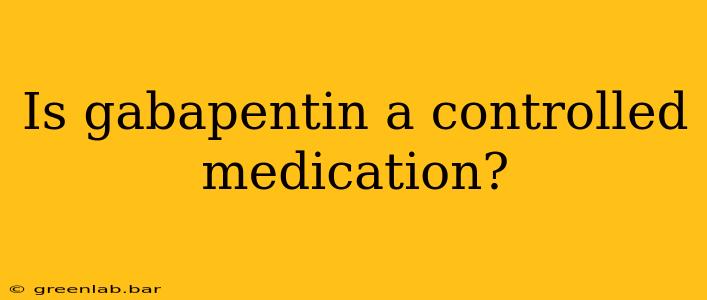Gabapentin's legal status often sparks confusion. While it's not a controlled substance in the same vein as opioids or benzodiazepines, its potential for misuse and abuse is increasingly recognized, leading to ongoing discussions about its regulation. Let's delve into the details to clarify its classification and potential risks.
Gabapentin's Schedule: Not a Controlled Substance (Yet)
In the United States, Gabapentin is classified as a non-controlled substance. This means it's not listed under any of the Schedules of the Controlled Substances Act (CSA). This classification is consistent in many other countries as well. This lack of scheduling indicates that, unlike substances with high potential for addiction and abuse, the government currently doesn't consider Gabapentin to pose the same level of risk.
What does this mean in practice?
This means there are fewer legal restrictions on prescribing and dispensing Gabapentin compared to controlled substances. Doctors can prescribe it relatively easily, and pharmacists can fill prescriptions without the same level of oversight. However, this doesn't mean there are no restrictions. Responsible prescribing practices are still essential, and doctors should carefully consider the potential risks and benefits for each patient.
The Growing Concern Over Gabapentin Misuse
Despite its non-controlled status, Gabapentin misuse and abuse are on the rise. Several factors contribute to this growing concern:
- Increased Prescriptions: The widespread use of Gabapentin for various conditions, including nerve pain, epilepsy, and anxiety, has led to a greater availability of the drug.
- Relative Ease of Access: Its non-controlled status makes it easier to obtain, compared to controlled medications.
- Euphoric Effects at High Doses: While intended therapeutic effects differ, some individuals report experiencing euphoric or sedative effects at higher-than-prescribed doses, leading to recreational use.
- Potential for Dependence: Although not as physically addictive as opioids, Gabapentin can lead to psychological dependence in some individuals, resulting in withdrawal symptoms upon cessation.
The Future of Gabapentin Regulation
The increasing awareness of Gabapentin misuse is prompting discussions about stricter regulations. Some experts and policymakers advocate for reconsidering its non-controlled status and potentially scheduling it under the CSA. However, such a move would require significant consideration of the potential impact on patients who legitimately benefit from the medication.
The ongoing debate highlights the complex interplay between public health concerns, responsible prescribing practices, and the need to ensure access to essential medications for those who require them. The current non-controlled status reflects the present regulatory assessment, but this is a dynamic situation subject to review and potential future changes based on ongoing research and monitoring of its use.
Conclusion: Understanding the Nuances
While Gabapentin is currently not a controlled substance, its potential for misuse requires responsible use and careful monitoring. Patients should always follow their doctor's instructions, and healthcare providers should remain vigilant in addressing the potential risks associated with Gabapentin prescriptions. Staying informed about evolving regulations and potential changes surrounding this medication is crucial for both patients and healthcare professionals.

